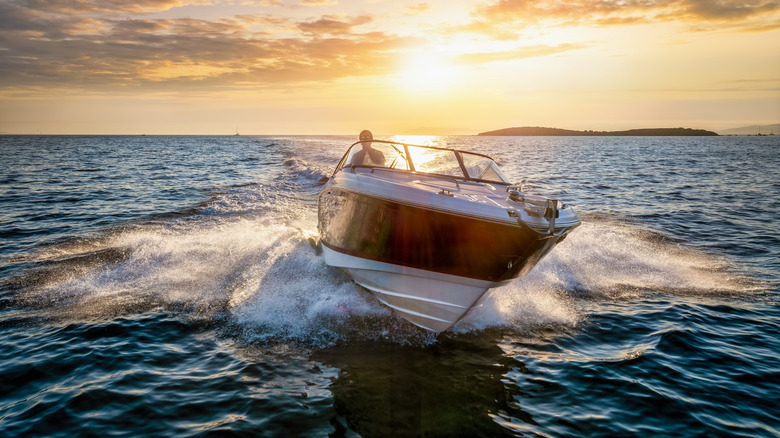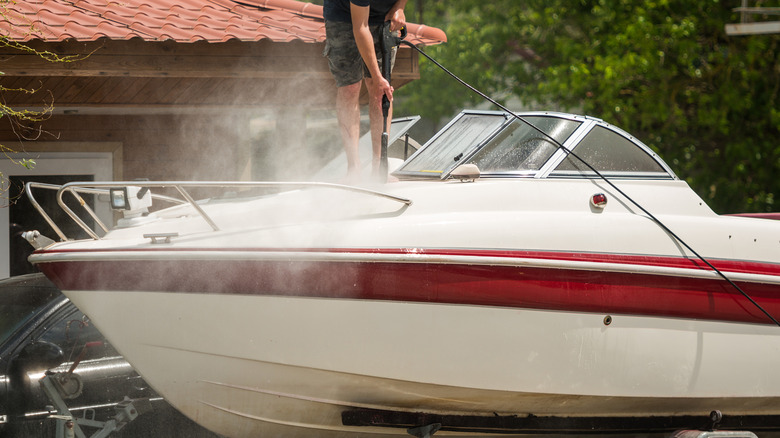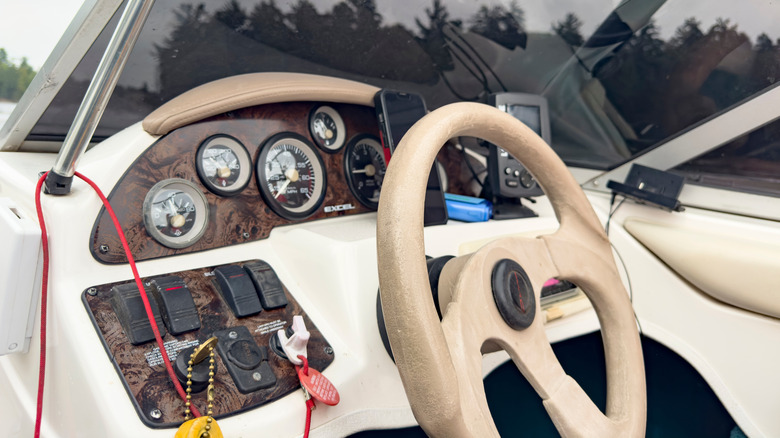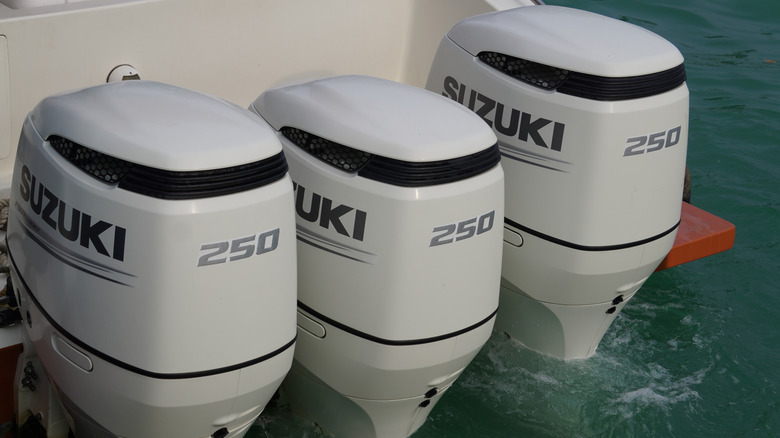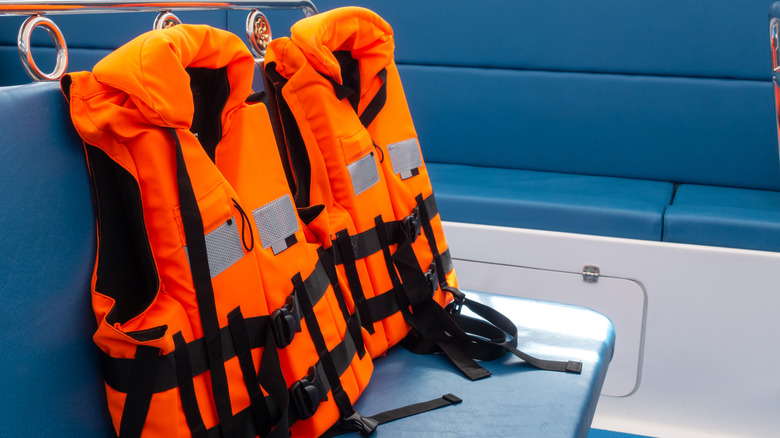Spring Boat Maintenance Tips You'll Wish You Knew Sooner
We may receive a commission on purchases made from links.
Spring's warming weather has many boaters anxious to hit the water. However, after a winter of little to no usage, there are several important maintenance tasks that should be performed before putting your boat in the water to ensure you have a safe and enjoyable outing. After all, there are plenty of potential issues that can arise, starting from when you are towing your boat to the water, as well as once you get underway. A breakdown along the road or on the water will certainly leave you wishing you knew about these spring boat maintenance tips sooner.
Performing spring maintenance on your boat and trailer includes many tasks that are relatively simple and can be done even by those who aren't mechanically inclined. The longer it has been since you've used your boat, the more important these tasks are to complete. Thoroughly inspecting every aspect of the trailer, boat, and engine will also help uncover any potential problems that may require a trip to the shop as well. Whether you perform the work yourself or end up taking it in to fix issues you uncover, taking care of these maintenance tasks early will make sure your boat is ready to go and you are able to enjoy plenty of carefree days on the water during the spring and summer.
Give your boat a good cleaning and inspection
The first step in your spring boat maintenance includes the most basic of tasks, ranging from a good cleaning to a thorough inspection. Start by giving your boat a wash with water and Star Brite Sea Safe Boat Wash or similar product. During the wash and rinse process, check to make sure all the drain holes and/or scuppers are free of debris and draining properly. If you have a Bimini top or other similar type of cover, open it and clean it as well. Once the boat is dry, wax the hull, polish any metal, and wipe down windshields and gauges.
While washing and waxing the hull, you should keep an eye out for any cracks or chips. Small, superficial cracks can be repaired with a gel coat repair kit. Structural cracks will need to be repaired by a professional, unless you are handy with fiberglass. You should also check to make sure all rails, handles, and seats are secure and in good condition. Tighten or replace hardware as necessary. Inspect all hatches and latches to make sure they are in working order. Lubricate or replace as necessary. WD-40 is great for wiping down metal boat parts to prevent rust and corrosion.
Since you are already going through the hatches, make sure all the necessary equipment for tying up and/or anchoring, including dock lines, anchor, anchor rope, and bumpers, are in good condition and easy to access. Now is also a good time to check that your boat registration is current and all the necessary documents are encased in a waterproof pouch and stowed in an accessible location. The same goes for insurance policy and any required operator licenses.
Check your boat's fuel and electrical systems
Next up is to check the systems that make your boat start and go. Begin by inspecting all of your fuel lines. Make sure they aren't dry or cracked. Any worn hoses should be replaced. Then make sure all the hose clamps and fittings are secure. If you have an inline fuel filter, replace it. Debris can settle during periods of non-use. Inline filters are relatively inexpensive and easy to change, so it's not worth the risk of ruining a trip from a clogged filter or injector. The same goes for the primer bulb. If it is dry, cracked, or soft, replace it. Finally, make sure your throttle cable is in good shape and moves freely.
After thoroughly going through the fuel system, move on to the electrical system. Start by checking your batteries to ensure they are not only charged, but holding a charge. Reinstall or reconnect them if they were removed for winter. Make sure all the contacts and connections are clean and secure. It's a good idea to coat the terminals with a thin layer of grease to prevent rust and corrosion.
From there, systematically turn on every electrical component to make sure it is still functioning. This includes running lights, cockpit lights, gauges, horns, and bilge pumps. If any of these do not work properly, first check the connections, as loose or corroded connections are often the culprit. Fuses and switches are also common issues. Otherwise, you may need to look at replacing the part and/or the wiring. Then move on to other electronic devices such as GPS and sonar units. Again, troubleshooting for non-functioning units would start with devices, then move on to fuses and switches before zeroing in on the unit itself.
Boat engines require a bit of maintenance
Now it is time to take a look at what most people consider the most important part — the engine. Both outboard and inboard engines require a bit of maintenance to get ready for the season. First up is to change the engine oil and filter, unless you have a two-stroke engine or already changed the oil and filter before storing your boat for winter. This is a good time to clean or replace spark plugs and replace any internal fuel and air filters. Next, check or change the lower unit oil. If the oil has a milky look, you need to take it to the shop, as this is an indicator that water has entered the lower unit, either through the seals or via a crack in the lower unit itself.
While you are working with the lower unit, take a look at your propeller. Make sure there are no major dents or dings. It is actually a good idea to pull the prop and grease the shaft. You should also look for any fishing line or other debris wrapped around the prop shaft. The next step is to inspect the anodes and replace if necessary. These chunks of zinc are critical for keeping your boat and motor corrosion-free, but they deteriorate over time. If they are noticeably smaller, replace them.
Then, move on to the steering system. Grease the system by adding grease through the inserts found at various points along the cabling. Turn the wheel back and forth to make sure it moves freely. Then, check the hydraulic trim fluid. Tilt your engine up and down to ensure the lift is functioning properly. Finally, hook your outboard up to muffs like the SeaSense Dual-Flow Motor Flusher and make sure it starts.
Don't overlook taking care of your trailer
Of course, no matter how well your boat looks and runs, you can't use it if you can't get it to the water. That is where the trailer comes in, so it's important not to overlook it as you go through your spring maintenance. The first step is to inspect all tires. Make sure they are properly filled. Add air as necessary. Also, check for worn tread, cracks, or bulges. If the tires aren't in good shape, don't risk a blowout. Replace them before towing your boat. Don't overlook the spare, as it also has to be in good shape. This is also a good time to make sure you are able to break the lugs free, as they tend to freeze up after being repeatedly submerged in water. Before moving on from the tires and wheels, be sure to grease the bearings.
Next, inspect the bunk boards and brackets, as well as the winch and winch strap. Grease the winter and jack stands. Make sure each moves freely. If the winch strap is worn or sun-dried, replace it. Check any other tie-down straps as well. Move on to check the safety chains and tongue lock, lubricating and replacing as necessary. Also inspect all rollers and pads. Finally, plug in your trailer lights and make sure they are fully functional. If they are not working, check fuses, bulbs, and connections. Should they still not work, you may need to replace the light fixtures and/or wiring harness.
Emergency equipment must be in good working order
Now that you have the boat, motor, and trailer in good working order, it is time to make sure you have all the necessary emergency boating equipment in place. Check flares and fire extinguishers to make sure they are still within date. If they are expired, replace them. You should also refresh yourself on how to safely use distress flares and fire extinguishers. Go through your first aid kit, replacing any expired or missing items. Place all these items in an easy to access, waterproof hatch or storage box, along with a flashlight and spare batteries.
Next, inspect all lifejackets. Make sure you have an appropriate number — one for every passenger — and sizes, including the proper life jackets for kids, for any excursion you may take. Replace any life jackets that are in poor condition. Before returning them to a storage hatch on the boat, it's also a good idea to wash and dry them thoroughly. Per USCG regulations, you also need to have at least one throwable floatation device on board.
Finally, make sure you have a sound signaling device, even if your boat is equipped with an electric horn. Whistles and air horns are good examples of manual noise makers. These devices should be easily accessible. It is also a good idea to have a functioning compass, whether it be handheld or mounted, even if you have an electronic navigation unit.
